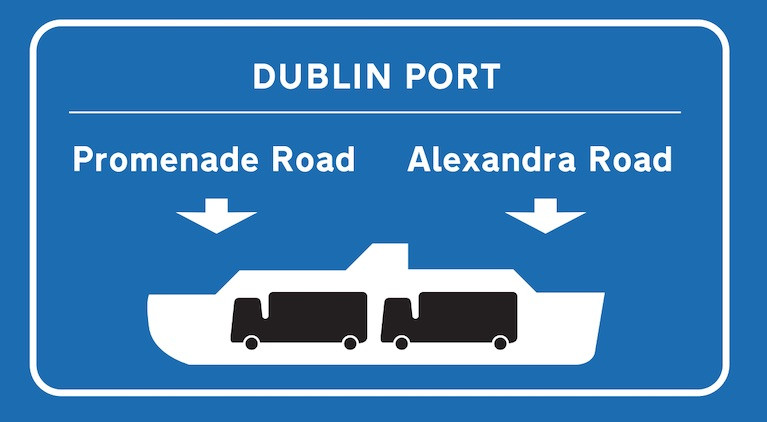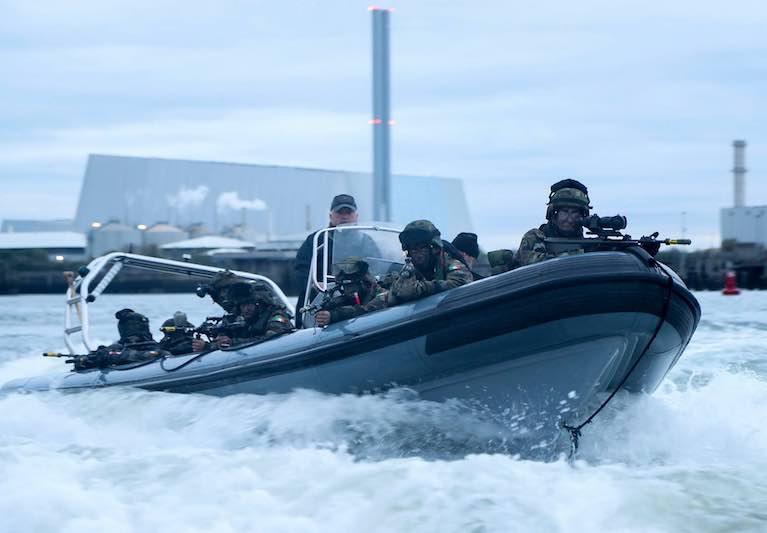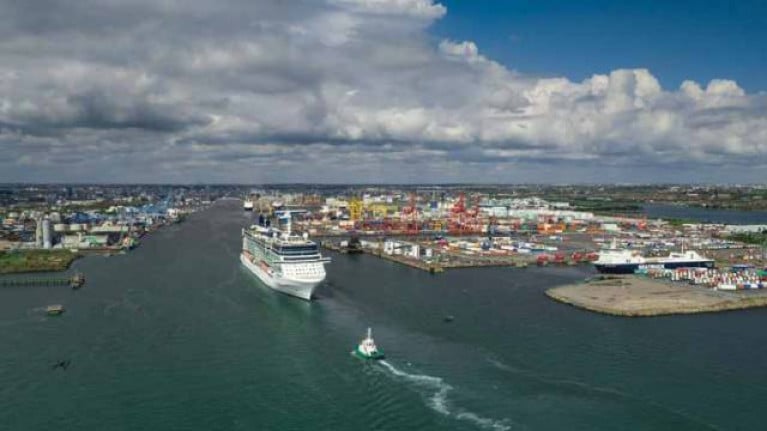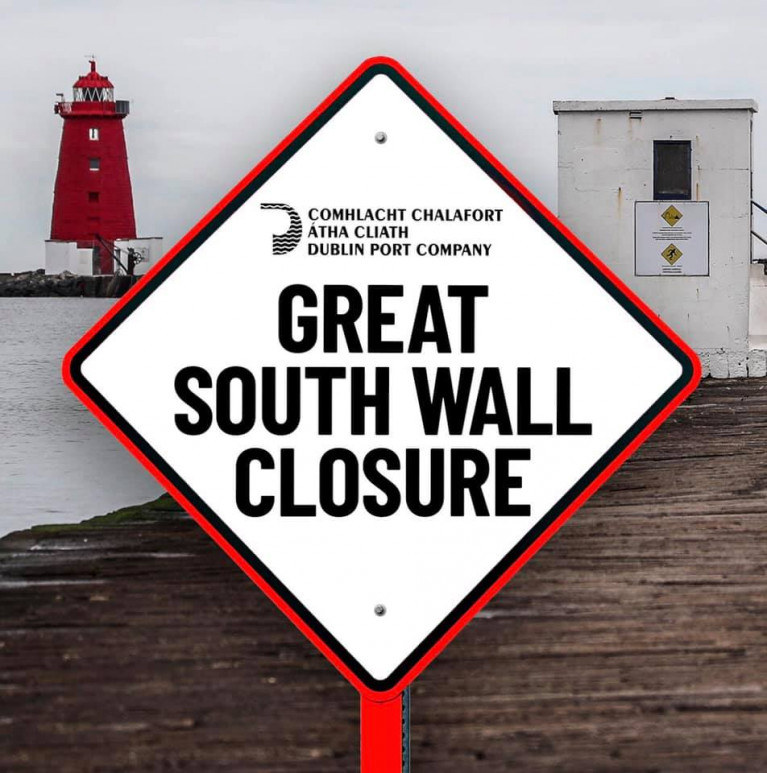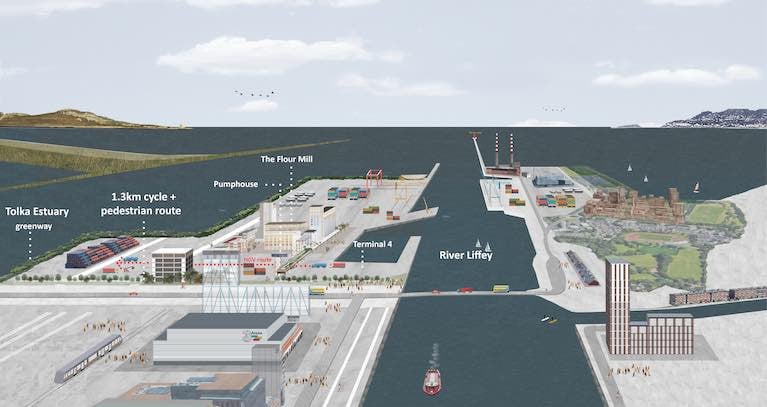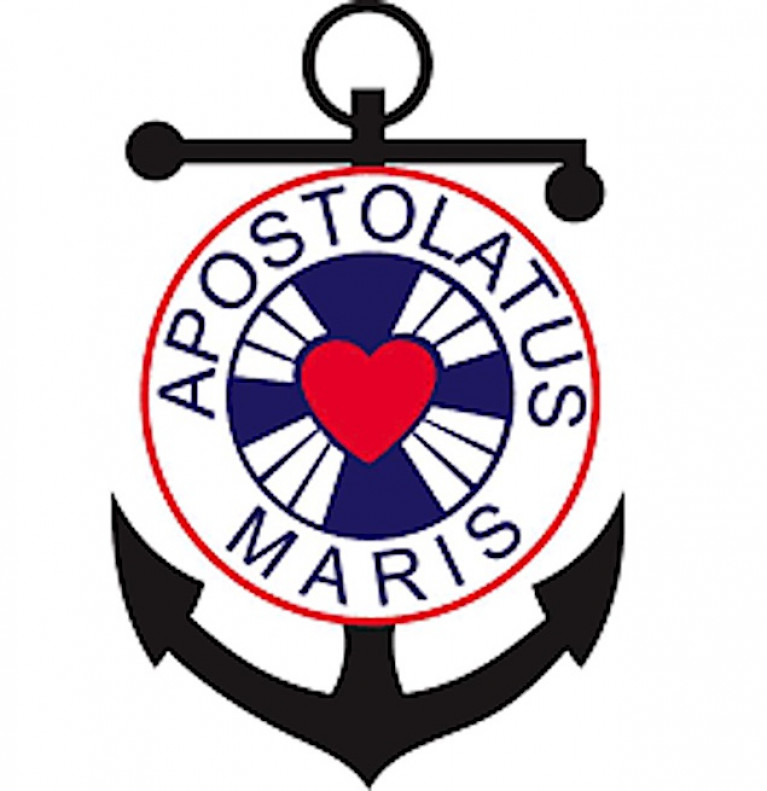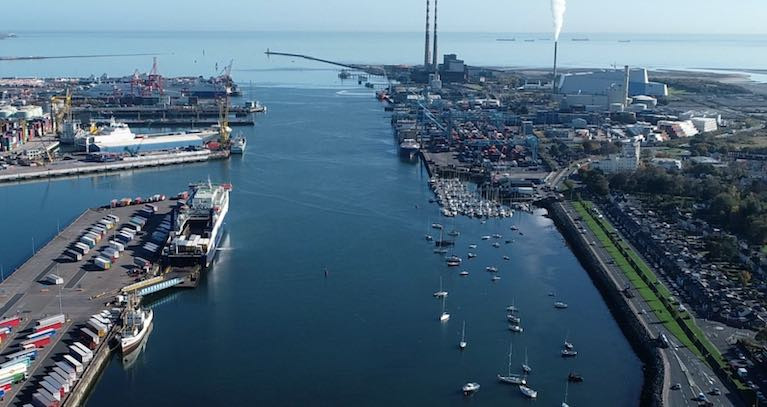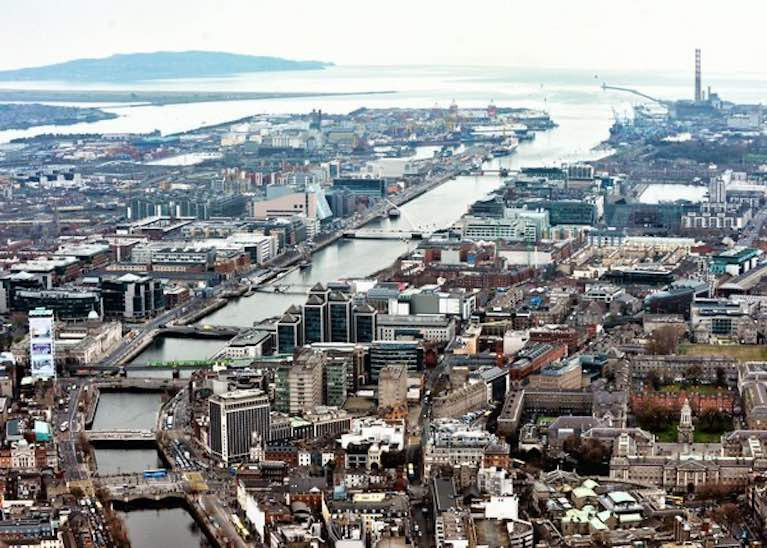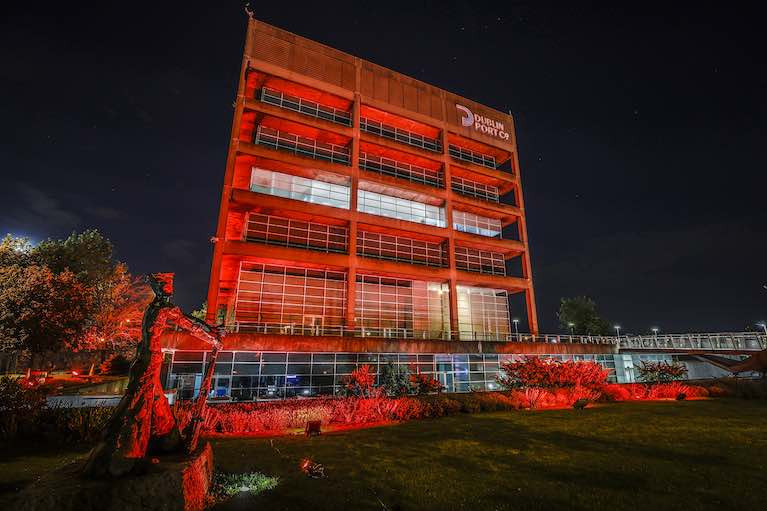Displaying items by tag: Dublin Port
Dublin Port Completes Major Road Works & New Traffic Management Measures in Advance of Brexit
With just over two weeks to go before the re-introduction of border controls on goods arriving from Great Britain, Dublin Port Company (DPC) has today announced:
- The completion of works to increase the capacity of Dublin Port’s internal road network; and
- The introduction of new internal traffic management measures to keep traffic flowing through Dublin Port.
The new measures are being introduced this week and will be in full effect in advance of the introduction of the new border controls on 1st January 2021.
The improvements and changes are detailed in a new booklet, Six Key Messages for Hauliers.
Even with additional road capacity and traffic management measures in place at Dublin Port, all operators and port users have their part to play to keep trade flowing and ensure that extreme contingency plans are not needed in response to congestion. This is especially so in the first 90 days of 2021.
The challenge for State agencies - notably Customs and the Department of Agriculture, Food and the Marine (DAFM) - is to apply border inspection controls efficiently around the clock on six times the volume of goods that were arriving off ferries 28 years ago when the Single European Market removed the need for such controls.
As part of the challenge to prepare for Brexit, eight inspection facilities have been constructed for Customs and DAFM by DPC and OPW at six different locations in Dublin Port. Dublin is already a busy port and the additional requirement for hauliers to move trailers between ferry terminals and these eight different facilities will increase traffic levels within the port for the same volume of cargo.
Greater separation between the arrival times of the Holyhead ferries would greatly reduce the risk that the inevitable delays which border checks will cause might escalate to the point of congestion.
In addition to the timing of ferry arrivals, there are busy container terminals in Dublin Port with high levels of HGV traffic particularly in the early morning and late afternoon on weekdays. The collection of containers from terminals needs to be scheduled by the container terminal operators, the hauliers and the cargo owners to reduce peaks and prevent excessive queues building on the port’s internal road network.
Brexit delays are inevitable - congestion is not.
Announcing the new measures, Eamonn O’Reilly, Chief Executive of Dublin Port Company commented:
“The continued congestion-free operation of Dublin Port post-Brexit requires all port users to play their part. Since 2018, DPC has spent €30 million to make assets and infrastructure available to OPW to provide Border inspection facilities on eight sites covering a land area of 14.6 hectares. There is now 16,000 square metres of warehousing with 25 loading bays giving an annual capacity for well over 100,000 physical inspections of containers and trailers.
“There is huge infrastructural capacity in place and the challenge now is to use this capacity efficiently to ensure that goods keep flowing. There is a simple and obvious measure of success and that is the ability of hauliers to provide their essential services without being delayed in Dublin Port. The six key messages we have published today are intended to help achieve this objective. Delays because of Brexit border checks are inevitable, but congestion is not.
“Even with continuing works on the port’s road network in recent times, we have recently seen two of the busiest months ever for unitised trade and traffic has flowed smoothly into and out of the port. In October - the second busiest month in the history of Dublin Port - our unitised trade was 2.2% ahead of last year; November - the fourth busiest month ever - was 12.2% ahead. Now that the road works are complete - and even with the introduction of border controls in January - there is no reason why traffic should not continue to flow freely so long as all supply chain operators play their part.
“The closeness in the arrival times of ferries from Holyhead is an obvious cause of concern in January and brings with it the risk of delays being increased to the point of congestion on the road network within Dublin Port. We have asked the two ferry companies operating the Holyhead services to bring the arrival time of the first ship in each of the four daily waves forward and to bring the second ship in somewhat later in order to flatten the demand curve for incoming HGVs. In making this request we guaranteed to the ferry lines that they could return to their current slot times at any time during the first 90 days after the new border controls come into place. Disappointingly, one has refused our request and the other has yet to respond.
“Supply chain behaviour is going to have to change after Brexit and hauliers need to know what they can expect in terms of waiting times for border inspections by State agencies. It is important for hauliers and their customers - the cargo owners - to know how long the different types of checks by Customs and DAFM will take so that they have some sense of the delays they will face and are able to plan their operations accordingly.
“DPC and hauliers have a shared objective to keep goods flowing and we depend on the State agencies, the ferry companies and the container terminals to each do their part. We would particularly encourage hauliers to demand service levels from container terminals and sailing times from ferry companies that meet their needs.”
Summary of Traffic Management Measures inside Dublin Port
Port Entry and Exit routes – Major road works have been completed in the vicinity of the Circle-K service station and there is now full dual carriageway access and egress to Dublin Port along Promenade Road linking directly to the Dublin Port Tunnel.
From 1st January 2021, HGVs will no longer be permitted to exit Dublin Port from Alexandra Road onto East Wall Road.
Also, from 1st January 2021, HGVs accessing specified locations along Alexandra Road will be required to enter the port directly from East Wall Road. All other HGV traffic will enter via Promenade Road.
Ro-Ro ferries:
For green-routed HGVs and tourist traffic arriving directly from Holyhead ferries, there is a direct, simple and well signposted 1,800 metre route to the Port’s exit on Promenade Road.
For red-routed traffic, there are two specific routes to be followed to either T7 (1,400 metres) or T11 (1,500 metres) as required by Customs.
Post Brexit, the timing requirements and needs of hauliers and cargo owners may change to the extent that current ferry arrival times might no longer meet their requirements. If that is the case, DPC encourages hauliers to tell the ferry companies what their requirements are.
Container terminals – It will be necessary to prevent queues for container terminals backing out onto Alexandra Road and Tolka Quay Road. If this happens, DPC will manage these queues actively and HGVs may be asked to leave the Port to prevent the onset of congestion. DPC encourages hauliers to insist that container terminals provide booking slots to prevent drivers having to queue excessively.
Dublin Port Tunnel – In the worst case, the contingency plan recently announced by the Department of Transport to deal with the impact of port congestion on roads outside Dublin Port will be implemented. This could include U-turning traffic exiting the southbound bore of the Dublin Port Tunnel before it enters Dublin Port and directing it back through the northern bore of the tunnel to designated parking areas.
All of the above measures are designed to maintain the efficient flow of HGVs within Dublin Port and prevent delays in port traffic escalating to the point where traffic on roads adjacent to the Port or on the national motorway network are affected.
The new booklet Six Key Messages for Hauliers is available to download below.
Irish Defence Forces To Carry Out Military Exercise in Dublin Docks
The Irish Defence Forces say they will be conducting a military exercise in the Poolbeg area of Dublin Docks tomorrow morning between 6 & 9.00 am
The exercise aims to test junior leaders in a Military Operations in Urban Terrain (MOUT) environment & will involve low flying helicopters, boats & pyrotechnics.
The 'public notice' was posted via the Defence Forces Facebook page.
Brexit-Related Traffic Management Plans for Dublin Port & Dublin City
Minister for Transport, Eamon Ryan TD, and Minister of State, Hildegarde Naughton TD, have today announced details of the Brexit-related Traffic Management Plan for Dublin Port and Dublin City.
These contingency plans will be in place from 1st January, 2021, to mitigate the impact that Brexit-related traffic congestion may have on Dublin Port and the potential knock-on impacts on Dublin City (particularly the Port Tunnel and motorway system).
Overview of the Traffic Management Plan
These plans have been formulated by the Traffic Management Group, chaired by the Department of Transport, which includes representatives of Transport Infrastructure Ireland (TII), Dublin City Council (DCC), An Garda Siochána (AGS), Office of Public Works, Revenue Commissioners and Dublin Port Company (DPC). The Traffic Management Group was established to develop and undertake the contingency responses necessary to deal with potential congestion at the port and surrounding areas.
The traffic management plan is based on a colour coded Traffic Light System: Status Green, Status Amber, Status Red and Status Blue with associated communication plans and mitigation actions which are built on cross-organisational cooperation and response.
 Figure 1: Queue Management on M50 Northbound approach to M1/M50 Junction
Figure 1: Queue Management on M50 Northbound approach to M1/M50 Junction
 Figure 2: Overhead Signage for M50 Northbound approaching M1/M50 Junction
Figure 2: Overhead Signage for M50 Northbound approaching M1/M50 Junction
There will be a hierarchy of interventions by relevant agencies based on the level of congestion impacting on Dublin Port, the Port Tunnel, city roads and M50/M1, this includes:
- Enhanced traffic spacing at the northern Dublin Port Tunnel entrance
- A queue management system for Heavy Goods Vehicles (HGVs) on M50 Northbound approach to M1/M50 Junction and on M1 southbound (see figures 1 and 2 attached)
- Additional HGV parking capacity at motorway service area’s on the M1 (both northbound & southbound).
- Off-line Emergency HGV Parking
- Turn-around facility at Tunnel Slip to Dublin Port (Promenade Road) (see figure 3 below)
- Assistance of An Garda Siochána and motorway service operators
 Figure 3: Turn-around facility to Dublin Port
Figure 3: Turn-around facility to Dublin Port
Traffic conditions in the Port and the adjacent roads including the Port Tunnel will be actively monitored and communicated via the DPC’s Ports Operation Centre, TII’s new combined Motorway and Tunnel control room and dedicated incident room, along with the DCC’s Traffic Control Centre. This will ensure that the Status in which the Port is operating is continually monitored and will provide the information necessary to trigger implementation of any phased traffic management response measures required.
Minister Ryan commented: “No matter what happens in the ongoing Brexit negotiations, there will be major changes in how we do business with the UK from January 1st This traffic management plan, which is the result of close collaboration by many different agencies, is designed to deal with any congestion that may arise due to increased level of checks at Dublin Port and to minimise the impact on the Port tunnel, nearby motorways and the rest of the city. We know that Brexit is a challenge for our hauliers, and thank them for their cooperation in ensuring they have the correct documentation to enter the port and that they follow the alerts and signage provided.”
Minister Naughton commented: “Many are worried about possible impacts on their business. But there will be profound changes in how we conduct business and each sector of the supply chain must mitigate the risks within their own control. Importers, exporters, hauliers and logistics companies will have to examine and adopt new ways of doing business. We are asking all port users to be aware of the fact that there is potential for congestion and to pay attention to new signage that will be in place to guide traffic through any imposed diversions.
Information to drivers will be disseminated via various channels and we ask that drivers familiarise themselves with these channels and stay tuned for regular radio updates on Dublin City Council’s Live Drive.”
The ultimate aim of the traffic management plans is to ensure that there is minimal disruption to the flow of movement in Dublin Port and surrounding city, which can only be achieved if all stakeholders undertake to prepare to the best of their ability.
Ministers Ryan and Naughton are also calling on all Hauliers, Transport Companies and Port users to be alert to following –
New customs and other regulatory control procedures
Hauliers will not be able to board ferries to and from UK from 1st January 2021, unless all necessary documentation has been completed in advance and properly presented. Familiarisation with the appropriate regulatory requirements required for import and export controls is an essential component to facilitating a smooth flow of trade. It is recognised that a large administrative burden will arise for those trading with the UK from 1st January. Therefore, all stakeholders are encouraged to engage before the new year with the relevant State agencies who are more than willing to provide assistance and guidance in relation to these new processes and procedures.
Hauliers may be subject to checks by State agencies on arrival by ferry into the Port. Information on which hauliers will be subject to checks and which will be free to exit the Port directly will be available 30 mins before the ferry docks. Signage will be in place to guide hauliers to the appropriate State compound or to the Port exit.
Be aware of potential congestion and traffic diversions
All Port users should be aware of the fact that there is potential for congestion and to pay attention to new signage that will be in place to guide traffic through any imposed diversions. In the event of high levels of congestion, traffic management contingency plans will be activated and will apply to all vehicles.
Stay alert to congestion updates
Information to drivers will be disseminated through various channels. Drivers should stay tuned for regular radio updates on Dublin City Council’s ‘Live Drive’ radio station (103.2FM) and national broadcast updates. Information on congestion will also be sent out via national websites, including; www.dublinport.ie; www.dublintunnel.ie; www.hgv.ie (DCC website) and social channels such as @DublinPortCo, @TIITraffic and @GardaTraffic.
Dublin Bay's Great South Wall Closed Due to Tide Height & Dangerous Winds
Due to the forecasted Southerly winds issued by Met Eireann for Sunday 15th and Monday 16th November 2020 combined with approaching high spring tides of 4.3m and a possible tidal surge of 0.45m which may pose a risk to walkers Dublin Port Company will temporarily close public access to the Great South Wall from the following times:
- Saturday, 14th November 20.30hrs – Sunday 15th November 00.45hrs
- Sunday, 15th November 21.15hrs – Monday 16th November 01.30hrs
The Great South Wall closure is due to tide height and dangerous winds on the exposed wall surface.
High Spring Tides
Meanwhile, Dun Laoghaire Coastguard has warned that The Forty-foot and along the Dublin Bay coastline today and over the next few days, will have high Spring tides which will make it very difficult for swimmers.
"Please take heed of any warnings and don’t take risks", the Coastguard has urged.
High Water, Dublin
- Sunday 15 November 11.10am
- Monday 16 November 11.54am
See south shore, Dublin Bay webcam at Sandycove here
Dublin Port Appoints Architects to Create New Cycle & Pedestrian Route to Join River Liffey to Tolka Estuary
Dublin Port has today reached an important milestone in delivering Masterplan 2040 with the appointment of Grafton Architects to design the Liffey-Tolka Project, the most important Port-City integration project to date.
The Liffey-Tolka Project will create a new public realm along a 1.4 km dedicated cycle and pedestrian route linking the River Liffey with the Tolka Estuary through Dublin Port lands on the east side of East Wall Road and along Bond Road.
The new linear space ranges from twelve metres to nine metres wide and will be an extension of the campshires on North Wall Quay.
The Liffey-Tolka Project will bring cyclists and pedestrians from the Liffey to the start of a second Port-City integration project, the Tolka Estuary Greenway.
 A graphic of the Dublin Port Company Liffey/Tolka Project that will create a 1.4km cycle path through port lands
A graphic of the Dublin Port Company Liffey/Tolka Project that will create a 1.4km cycle path through port lands
The Tolka Estuary Greenway is a 3.2 km route along the northern perimeter of Dublin Port overlooking the Tolka Estuary. Construction of Phase 1 (1.9 km) will start next month and works will be completed by Spring 2022. Phase 2 (1.3 km) will be constructed over the following five years as part of large port infrastructure projects to deliver additional Ro-Ro freight capacity at the eastern end of Dublin Port.
Dublin Port Company will apply to Dublin City Council for planning permission for Grafton Architect’s design for the Liffey-Tolka Project by April 2021 with a target to commence construction by September 2021 and to complete the works by the third quarter of 2022. The new route will include a dedicated bridge for cyclists and pedestrians to safely cross over the busy Promenade Road, the key artery that links Dublin Port to the Dublin Port Tunnel and one of the most heavily trafficked roads in the country.
Construction of the new civic space will transcend the opening of the new T4 Ro-Ro freight terminal as part of the Alexandra Basin Redevelopment Project. As an indication of its scale, the T4 terminal will provide more Ro-Ro freight capacity than Rosslare Harbour. More importantly, the opening of T4 will allow Dublin Port Company to close one of the HGV entrances on East Wall Road and to redirect heavy goods traffic onto Dublin Port’s internal road network thereby greatly reducing heavy traffic along one of the city’s most hostile stretches of urban road.
Commenting on Grafton Architects’ appointment, Eamonn O’Reilly, Chief Executive of Dublin Port Company said: “Delivering Masterplan 2040 is very complex and our focus to date has been on projects which deliver additional freight capacity. However, an equally important, albeit smaller part, of our Masterplan is integrating Dublin Port with Dublin City.
“We have been delivering projects such as the Diving Bell in 2015 and the Opening of Port Centre in 2017 as isolated stepping stones to integrate the Port with the City but, with today’s appointment of Grafton Architects to design the scheme to link the Liffey with the Tolka, we have cut the Gordian knot of the complex challenge to open up Dublin Port to Dubliners.
“Dublin Port is not going anywhere, and we are committed to developing nationally important port infrastructure in accordance with the principles of proper planning and sustainable development. This requires us not only to cater for the needs of cargo and commerce; we must also create real gain for the citizens of Dublin.
“Within two years, we will have completed a dedicated cycle network throughout Dublin Port and along most of the Port’s perimeter. Doing this in a small but extremely busy port requires great design and we are delighted to be working with Grafton Architects as we take on a unique challenge to integrate Dublin Port with Dublin City.
“We have been working with Grafton Architects for the past year to prepare the Flour Mill Masterplan as the blueprint for the redevelopment of the former Odlums Flour Mill on Alexandra Road. This development is an integral part of our plans to deliver the €1.6 billion of port infrastructure projects required to bring Dublin Port to its ultimate capacity by 2040
“Developing masterplans is one thing; but turning great design into completed projects is the real challenge. We are delighted to have the empathy and expertise of Grafton Architects to help us realise our ambitions as we link the River Liffey to the Tolka Estuary. We couldn’t be in better hands.”
Commenting on Grafton Architects’ appointment by Dublin Port Company, Shelley McNamara said: “An influential and important exhibition took place at The Museum of Modern Art in New York in 2010 with the title Small Scale: Big Change. The architectural projects exhibited were transformative in their effect rather than their size and highlighted the capacity for incisive creative thinking to open up new possibilities within communities and cities
“The Liffey-Tolka Project to connect the River Liffey to the Tolka Estuary, along East Wall Road and Bond Road is not so small but, at the scale of the City it might be considered to be. However, its transformative effect will be immense.
“The currently hostile East Wall Road will become a linear Civic Space. This will form a new sense of entry to the City when travelling from the North and from the Dublin Port Tunnel.
“The drama, scale and animation of the Port will be revealed, joining up with the life of the City. The visual barrier which currently separates these two interdependent worlds will disappear. The pavement area will increase from a two metre width to twelve metres, offering a safe pleasurable landscaped space for people to walk or cycle. This new ribbon of space, bridging over Promenade Road, will connect the East Coast Trail and Dublin Port’s Tolka Estuary Greenway to the Liffey, terminating in a sunny public space on the water's edge. This will be a new Urban Amenity for day to day use and for enjoyment in times of leisure.
“We developed a deep appreciation and understanding of Dublin Port from our work on The Flour Mill Masterplan and we are very excited now to have been appointed to bring a project as important to the City as the Liffey-Tolka Project to the consenting phase and, hopefully, to construction next year.”
Seafarers Ceremony on Dublin Quays Cancelled
The annual national seafarers' remembrance ceremony in Dublin has been cancelled.
The City Quay Seafarers Memorial Service Organising Committee, consisting of the Maritime Institute of Ireland, Stella Maris Seafarers Centre and Dublin Port Company, announced that, due to the current Level 5 Covid-19 restrictions, the Annual Wreath Laying Service at the City Quay Seafarers Memorial "is regretfully cancelled for 2020."
"Last year's well-attended commemoration showed that interest in this annual memorial event remains strong which is heartening indeed. Hopefully, we will have the opportunity to convene once again next year to honour and preserve the memory of seafarers lost at sea in peacetime and in war aboard Irish merchant ships and fishing vessels," the organisers said in a statement.
Dublin Port Throughput Increases by 1.2% in Third Quarter
Dublin Port Company has today reported its third-quarter trading figures for 2020. The latest figures show an increase in overall port tonnage of 1.2% for Q3. After nine months, volumes are down by -6.9% compared to the same period last year.
Having seen a decline of -4.8% in Q1 (which had been attributed to Brexit stockpiling in the first quarter of last year), there was a further and steeper decline in Q2 of -17.0% as Covid-19 impacted the country. Since then, monthly trade volumes have been comparatively strong culminating in growth of 1.2% in the third quarter from July to September.
The growth of 1.2% in Q3 has been export led. Exports for the three months grew by 6.6%, more than offsetting the -2.4% decline in imports.
Unitised trade (trailers and containers combined) grew by 3.1% to 384,000 units during Q3 with Ro-Ro growing by 4.1% to 276,000 units and Lo-Lo by 0.2% to 192,000 TEU.
Imports of new trade vehicles through Dublin Port in Q3 decreased marginally by -0.6% to 12,400 units. For the nine months to September, 53,000 new trade vehicles have been imported through Dublin Port, a decline of -29.3% compared to last year.
Bulk liquid volumes, primarily petroleum products, declined by -20.4% to 972,000 tonnes during the quarter and are down by almost the same level (-18.4%) year to date.
Bulk solid commodities (including animal feed, ore concentrates from Tara Mines, bulk cement products and scrap metals) grew by 56.0% to 515,000 tonnes
Ferry passenger numbers decreased by -66.2% to 264,000. This figure includes HGV drivers. The number of tourist vehicles fell by -64.6% to 79,000.
There were no cruise ship calls to Dublin Port in Q3 and none is anticipated for the remainder of the year.
Commenting on the Q3 figures, Dublin Port’s Chief Executive, Eamonn O’Reilly, said:
“We had a weak start to the year with volumes down in the first quarter by -4.8% because last year began so strongly due to Brexit stock-piling. The second quarter was very poor with volumes down by -17.0% as Covid-19 hit. To see growth of 1.2% in the third quarter is remarkable and the outlook for the full year is nowhere near as bad as we had feared it might be just a few months ago.
“At the rate we are going, we could end the year down by not much more than -6.0%. By comparison, after the peak of 2007, we saw declines of -4.4% in 2008 followed by -10.4% in 2009. Importantly, our monthly volumes during this recession are a million tonnes ahead of where they were at the corresponding point in the previous recession.
“We have seen growth in export volumes in each of the last four months and strong growth in unitised volumes (Ro-Ro and Lo-Lo combined) of 3.1% in the last three months.
“The most dramatic impact from the recession has been the decline of one-fifth in petroleum imports both in the third quarter and year to date. One-third of all of the country’s energy requirements are met by petroleum imports through Dublin Port. We now have planning consents in place to redevelop what is, today, nationally critical energy infrastructure for other cargo handling purposes as the country moves away from hydrocarbons. Covid-19 has given us an insight into the coming energy transition, and we have prepared for it
“While the impact of Covid-19 is a continuing challenge, we are now also facing into the uncertainty and unknowns of Brexit in less than three months’ time. On the plus side, there has been a significant addition of new services and capacity on direct routes to Continental Europe in recent months - including to Rotterdam, Zeebrugge, Santander and Leixões - giving more options to the landbridge route for shippers who can cope with longer transit times. In addition, we have been working intensively over the last two years with the OPW to provide infrastructure for border control and inspection services by State agencies and very substantial facilities are now in place and ready to go.
“However, Brexit, and how it will impact trade flows and port volumes, remains a major unknown. Like everyone else, we hope that a trade deal is done which obviates the need for much of the infrastructure that has had to be provided to mitigate this risk. Dublin Port Company alone has invested €30m to prepare for Brexit.”
If you were asked to name the real centre point of modern Dublin, you'd probably dodge the question by saying that it's somewhere along a line through O'Connell Bridge and Trinity College, and on up Grafton Street or Dawson Street. Either way, that would definitely be locating the city's contemporary focus. Yet four hundred years ago, this modern central axis would have been regarded as being out in the sticks, down in the marshy inner edges of Dublin Bay.
When Trinity College was founded in 1592, its official title described it as being "Near Dublin". It was clearly eastward of the significant mediaeval city walls by slightly less than a mile, and eastward too of the main port area on the River Liffey, which was still centred around what had been the Dubh Linn, the "black pool" much favoured as a berth by the Viking's ships when they set up the makings of a settlement which first achieved some sort of civic status in 841.
 Dublin as it was when the book begins, as recorded by Herman Moll's map of 1714. Trinity College is shown as "near Dublin", while building on the north side of the new St Stephens Green has only recently begun. When development of the south side of what was to become Merrion Square was started close to the east of Stephen's Green, a selling point for the new Georgian houses was their "refreshing sea view".
Dublin as it was when the book begins, as recorded by Herman Moll's map of 1714. Trinity College is shown as "near Dublin", while building on the north side of the new St Stephens Green has only recently begun. When development of the south side of what was to become Merrion Square was started close to the east of Stephen's Green, a selling point for the new Georgian houses was their "refreshing sea view".
The central location around what had become Dublin Castle remained the heart of town for centuries. But while there was gradual expansion in every direction with the northsider/southsider psychological divide across the Liffey seeming to arise almost immediately – basically it was the Ostmen (the Eastmen or Danes) to the Northside, Normans on the Southside - the real engine of the city's power was always inclined to move eastward.
In his mighty yet very readable tome Dublin Moving East 1708-1844 – How the City took over the Sea, sailor/historian Michael Branagan has set in context the process whereby Trinity College and its environs have become the heart of the city through the machination of urban and port development, such that the main port area has undergone a major shift over the centuries, and is now well to the east of the College. So much so, in fact, that the entire estate of Dublin Port – one of the sponsors of this book - is on land which simply didn't exist when the "College of the Holy and Undivided Trinity" came into being.
The word that is generally used for this land is "reclaimed", as though the nefarious sea had originally pinched it from the decent people of Dublin while they were asleep. Nowadays, with global sea levels rising, how it's described may well become academic. But there is no doubt that - back in the era on which the book focuses - there was some extraordinarily effective land-grabbing going on in Dublin at the sea's expense.
The outcome is the shape of the city as we know it today, much of which results from buccaneering land "reclamation" and inspired development by some extremely determined and occasionally roughshod people whose wealthy descendants became the very souls of civic respectability.
Michael Branagan is a real terrier when it comes to research, and the numerous footnotes to each chapter will lead the enquiring reader along many fascinating pathways of unusual information. Thus it makes for ideal lockdown reading, and if you permit yourself one chapter every two days, there's a month of absorbing and informative reading here. At the end of it, Dublin and its port will never seem quite the same again, and it will certainly seem even more interesting.
 A city transformed in 140 years - Dublin as it was around 1850. It was still much smaller than it is today, but the basic work had been done – often with very primate equipment – to create the basic structure for a city moving east.
A city transformed in 140 years - Dublin as it was around 1850. It was still much smaller than it is today, but the basic work had been done – often with very primate equipment – to create the basic structure for a city moving east.
In fact, those who care about Dublin remaining a vibrant port should see this book as required reading, and clearly one of those who care about the port beyond the call of duty is Eamonn O'Reilly, Chief Executive of Dublin Port Company, whose thoughtful foreword is much more than the usual politely token introduction, as it gives us further insights into an extraordinary and pioneering city/port system.
In its entirety, the book gives a sense of deeper understanding of why Dublin should continue to embrace its commercial port, rather than becoming some sort of synthetic skyscraper city, with the real working maritime heart torn out of it for re-location to some soul-less container terminal landing pier in the middle of nowhere.
It has taken a lot to make Dublin the special and unique place it is. Suggesting that the port activities should be moved elsewhere "because that's what they do in other capital cities" is a very lame argument indeed. Dublin is Dublin, and rightly or wrongly in this remarkable place beside its bay between the mountains and the sea, we do things our own way - and our way includes having ships and city in dynamic interaction. Michael Branagan has done everyone a great service in detailing the key years in which a primitive river haven was launched – with the use of some very primitive equipment – towards the transformed situation where it was ready to become the fascinating port city that we know today.
 Dublin and its port and bay today. While much of the channelled River Liffey in the port has been planned, a very welcome unintended consequence of the building of the South Bull Wall - accelerated by the addition of the North Bull – has been the natural development of the extensive nature reserve of Bull Island in the north of Dublin Bay, created by wind-driven sand augmented by tide-carried silt. This photo also emphasizes the very special role of Dun Laoghaire as virtually the sole access point to Dublin Bay as a waterborne sports and leisure amenity for the large population of South Dublin
Dublin and its port and bay today. While much of the channelled River Liffey in the port has been planned, a very welcome unintended consequence of the building of the South Bull Wall - accelerated by the addition of the North Bull – has been the natural development of the extensive nature reserve of Bull Island in the north of Dublin Bay, created by wind-driven sand augmented by tide-carried silt. This photo also emphasizes the very special role of Dun Laoghaire as virtually the sole access point to Dublin Bay as a waterborne sports and leisure amenity for the large population of South Dublin
Dublin Moving East 1708-1844
By Michael Branagan
320 pp, fully illustrated
Published by Wordwell, €35.
Dublin Port Turns Red to Support Fire Safety Week
Dublin Port Company has turned its landmark Port Centre building and The Diving Bell on Sir John Rogerson's Quay red to support National Fire Safety Week 2020, which runs until October 12th.
More than 60 of the city's iconic buildings will be illuminated red to raise awareness of fire safety, particularly in the home.
Two Dublin Port landmarks, “Port Centre” designed by Scott Tallon Walker and the Diving Bell on Sir John Rogerson’s Quay, were illuminated in red last night as more than 60 of the city’s iconic buildings turned red for National Fire Safety Week 2020.
National Fire Safety Week is an awareness initiative of the Fire Service in Ireland, run jointly with the Northern Ireland Fire and Rescue Service to help enhance fire safety, particularly in the home. This marks the first time that Dublin Port has been an active partner in the event. The landmarks will remain illuminated until October 12th.
The theme of this year’s Fire Safety Week is “Smoke Alarms Save Lives”. The campaign not only encourages people to have smoke alarms and test them, but also calls on the wider community to look out for each other, especially those most vulnerable and at risk.
“I would like to thank the operators of all these buildings for their support in helping to raise awareness of fire safety. We have had to be a bit more creative this year with our campaign and I am delighted that so many landmark buildings are taking part by turning red to highlight the fire safety awareness message and provide a visual reminder and cue for Fire Safety Week.” said Dennis Keeley Chief Fire Officer, Dublin Fire Brigade.
John Fairley, Dublin Port’s Land Operations Manager, said; “Dublin Port and Dublin Fire Brigade have enjoyed a close working relationship that goes back years, and it is an honour to stand side by side with our friends and colleagues in the Fire Service this October in support of Fire Safety Week. It’s a brilliant initiative coming into the winter months that reminds us of the simple steps we can all take to help stop fire, and I hope the message reaches as many as possible in our home and work communities.”
Dublin Port Require Roles At Sea and Ashore
Afloat has noted that the Dublin Port Company is currently recruiting for roles at sea and those ashore as part of efforts to achieve the port's Masterplan: 2012-2040, writes Jehan Ashmore.
The objectives of such job roles, requires skilled, dedicated and motivated staff and DPC invites applications for Tug Master and Marine Operatives.
For further information visit the port's website careers page by clicking this link for full job specifications.
Closing date for applications is Friday 21st August 2020. For much more details consult the links given throughout.
Afloat adds the port operates its own pair of custom-built tugs, the Irish flagged Beaufort and Shackleton introduced just over a decade go in early 2010 as part of a port related work-boat upgrade of its fleet. A Spanish shipyard built the pair and costing €6m apiece.
The Voith Schneider propelled tugs each have a 53t bollard pull capacity and formed Phase 2 of an upgrade programme to modernise by replacing ageing tonnage. The then new tugs along with other port work related craft were introduced a decade ago in an overall €16m investment by the port company.
More on the tug newbuilds were featured in Ships Monthly, June 2010 issue as part of the publication's 'Waterfront' column.
In addition Beaufort featured in 'Maritime' Dalkey series of the Dalkey Community Council Newsletter (Feb) 2016, see: p.13.






























